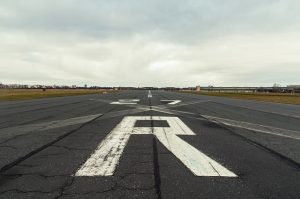
Runways play an essential role in commercial aviation. As you may know, they are stretches of natural or manmade surfaces on the ground that airplanes use for takeoffs and landings. All airports have runways. They provide pilots with a safe surface from which to take off or land.
#1) Require Rubber Removal as Maintenance
As a form of maintenance, rubber must be removed from airport runways. A typical commercial airliner will add about 1 pound of rubber per tire when landing or taking off. This is due to the friction between the tires and the runway. Friction creates heat that melts off a small amount of rubber from each tire. Airports must remove this added rubber so that it doesn’t build up and affect the integrity of their runways.
#2) Typically Made of Asphalt or Concrete
Most airport runways are made of either asphalt or concrete. Consisting of a mixture of sand and cement, asphalt is a popular choice because it’s inexpensive and readily available. Concrete, on the other hand, is more durable and longer-lasting.
#3) Blast Pads
There are sections before the start of runways that are designed to withstand the powerful jet blasts produced by airplanes. Known as blast pads, they keep the underlying soil and surrounding terrain safe from damage. Without blast pads, jet blasts would gradually erode the soil and terrain. Therefore, airports define a small section before each runway as a blast pad. Airplanes aren’t allowed to take off or land on blast pads. Rather, blast pads are used exclusively to absorb and withstand jet blasts.
#4) The Shortest Runway Is 1,312 Feet Long
Airport runways come in all different sizes. The world’s shortest runway, however, is that of the Juancho E. Yrausquin Airport. Located in the Caribbean, it measures just 1,312 feet long. What’s even more remarkable, perhaps, is that only about 900 feet of the runway are usable. Only highly skilled and confident pilots are able to land and take off at the Juancho E. Yrausquin Airport runway.
#5) The Longest Runway Is 18,045 Feet Long
The world’s longest airport runway measures a staggering 18,045 feet long. To put that number into perspective, that’s nearly three and a half miles long. It’s found at the Qamdo Bamda Airport in Tibet.
#6) Threshold Markings
Have you ever noticed the long, wide stripes painted on runways? These are known as threshold markings. They typically start about 20 feet after the beginning of the runway and extend to the end of the runway. Pilots use threshold markings to identify the usable part of a runway when landing.



